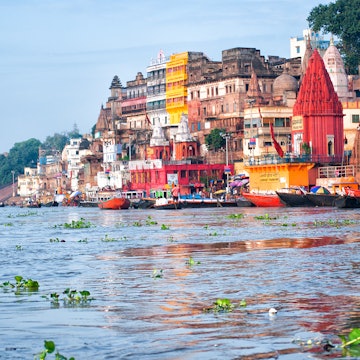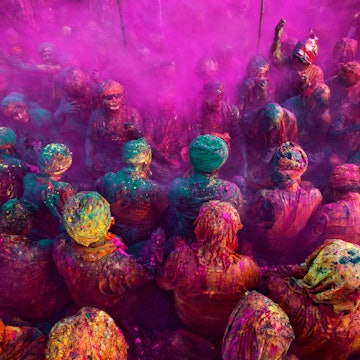
Rishikesh vs Varanasi: which of these two riverside Indian cities should you visit?



We asked two travel writers to go head-to-head over which is better, Rishikesh or Varanasi © Getty Images; iStock
Two Indian cities along the Ganges each have claims to fame.
Dubbed the “yoga capital of the world” for its numerous ashrams and yoga teacher training courses, Rishikesh is particularly popular among spiritual seekers (as well as those who are just in need of a good stretch). Follow the Ganges south and you'll find Varanasi, one of the holiest cities in Hinduism and a place that has drawn pilgrims for thousands of years.
In case you're not able to visit both, we asked two travel writers to go head-to-head, giving the case for the city closest to their hearts.

Rishikesh welcomes all to its ashrams and temples
During her six-year stint living in India, travel journalist Margot Bigg visited Rishikesh countless times, and once spent an entire month studying yoga in the city. Rishikesh remains one of her favorite weekend destinations from Delhi to this day.
The holy city of Rishikesh on the banks of the Ganges River — and its proximity to Uttarakhand’s four famous pilgrimage temples, collectively known as the Char Dham — has drawn in a steady flow of Indian travelers for many generations, but it wasn’t until the 1960s that Western visitors began coming here in great numbers.
Although the hippie trail has come and gone, one relic of the flower-power era remains: the ruins of the Maharishi Mahesh Yogi Ashram, nicknamed the “Beatles Ashram” in honor of the time that the Fab Four spent here studying Transcendental Meditation under the tutelage of the Maharishi himself. While you used to be able to slip a few rupees to a watchperson and explore the once-ramshackle grounds on your own, the ashram has since been taken over by the Rajaji Tiger Reserve. Today it operates as a proper tourist attraction, complete with signage, well-maintained passageways, a photo gallery and a small cafe.

The Beatles Ashram aside, most of Rishikesh’s historic ashrams and temples are active, thriving, and welcoming to all — including foreigners — unlike Varanasi, where temples either charge hefty fees for overseas visitors or simply ban them from entry altogether. Rishikesh is a friendly, welcoming place for seekers (and the spiritually curious), irrespective of their origin. Foreign visitors can hike up to the Neelkanth Mahadev Temple, study the teachings of Swami Sivananda — who wrote all his tomes in English — at the Divine Life Society or join the masses at the evening aarti ceremony (the auspicious lighting of lamps or candles) on the banks of the Ganges in front of the Parmarth Niketan Ashram, all without having to worry about being treated as unwelcome or inferior.

If you’re super into yoga, there’s no better place to be in India than Rishikesh. Here you’ll find all sorts of places to practice your asanas, from small schools teaching beginner-friendly classes in Hatha, Iyengar and Ashtanga yoga to challenging teacher training courses certified by the Yoga Alliance. And while some of the yoga courses in Rishikesh are undoubtedly hardcore, what’s not too intense — at least when you compare Rishikesh to more hectic spots such as Varanasi — is the experience of taking a stroll down the road. Sure, Rishikesh gets some big crowds, especially during particularly auspicious times of the year, but most stick to the main drags, meaning it’s easy to slip away and find a quiet spot to be alone with your thoughts. Plus, even in the main commercial parts of town, many of Rishikesh’s lanes and thoroughfares are only wide enough to accommodate motorbikes and pedestrians. Goodbye, incessant din of honking horns.

Rishikesh is only a couple of hundred kilometres from the Gangotri Glacier, the source of the sacred Ganges River. While there are some settlements between Rishikesh and the mouth of the river, most of the major industrial polluters are further downstream, meaning Rishikesh is considerably cleaner. In fact, the section of the river that runs through Rishikesh is clean enough to safely bathe or swim in — which definitely isn’t the case in Varanasi. It’s also a great place for whitewater rafting, and countless operators offer trips of varying lengths on the river, most of which are beginner-friendly. And while rafting is undoubtedly Rishikesh’s biggest draw for outdoorsy travelers, its location in the forest-fringed foothills of the Himalayas means that you’re never far from an opportunity for adventure, be it an invigorating forest hike or an adrenaline-filled bungee jumping experience. You certainly won’t find any of that in Varanasi.
Varanasi is a deeply spiritual sacred city
Traveling India to research Lonely Planet’s latest India guidebook, Monique Choy saw many amazing places. But there’s no place on earth that can match Varanasi’s concentrated connection with life’s mysteries.
Varanasi at dawn: in the milky light pilgrims make their way down the steps of the ghats. They weave between chai-wallas (tea vendors), yogis, sadhus and flower sellers, and quietly enter the sacred waters to perform puja (prayers), heads bowed in private communion with Mother Ganga. This is no spray-on spirituality, and Varanasi is no tourist town designed to cater to curious Westerners. Entering the sacred river in Hinduism’s most scared city is a deeply personal and spiritual moment, and one that’s drawn pilgrims here for thousands of years. People travel to Varanasi (aka Banares) from across India to wash away their sins, cremate their loved ones, deepen their spiritual knowledge, and also to die here, hoping for moksha, or liberation from the cycle of rebirth.

According to Mark Twain, "Benares is older than history, older than tradition, older even than legend and looks twice as old as all of them put together." While almost everyone who visits Varanasi falls in love with the city, most agree it is not for the faint-hearted. Intimate rituals of life and death take place in public, and the sights, sounds and smells of the mazelike old town can be intense.
Most of Varanasi’s 84 ghats are used for bathing, but there are also several "burning ghats" where bodies are cremated. Manikarnika Ghat, the main burning ghat, is the most auspicious place for a Hindu to be cremated. The open pyres on the ghat burn day and night, cremating up to 200 people each day. Dead bodies are handled by a caste-based community of cremation workers called doms, and are carried through the tangled alleyways of the old town to the holy Ganges on a bamboo stretcher, swathed in cloth. The corpse is doused in the river prior to cremation and the ashes are scattered in the water afterwards.
Confronting the reality and ritual of death and cremation is a powerfully moving experience, as is strolling the ghats with pilgrims at a high point on their spiritual quest, or watching the nightly ganga aarti, the moving river-worship ceremony performed by priests.

Spend a little time in Varanasi and you may take home more intangible benefits. The city is a center of education, as one local put it, it’s all about "burning and learning". The shaded campus of the Benares Hindu University is here, and the city is a great place to learn a new skill, you can take courses in Hindu mythology, Indian astrology and photography. You can learn how to speak Hindi, how to play the sitar, or how to make a three-course Indian feast. There are also many yoga schools, including some like DarkLotus, that take yoga out of the studio and onto the ghats.

From Varanasi, you can visit the nearby city of Sarnath on a day trip – another sacred center, this one hallowed by Buddhists. It was in Sarnath that Buddha gave his first sermon in a deer park after gaining enlightenment, known as the First Turning of the Wheel of Dharma. Once a bustling monastic center, it was sacked by Muslim invaders in the 12th century and fell through the cracks of history. The amazing Dhamekh Stupa & Monastery Ruins were uncovered again by British archaeologists in 1835 and now Sarnath is a pilgrimage destination for Buddhists from across the world.
Varanasi is the India of your imagination. While you won’t find exclusive wellness retreats, bungee-jumping or Beatlemania here, you may connect with something far more precious – few people leave Varanasi feeling unaffected by the experience.















